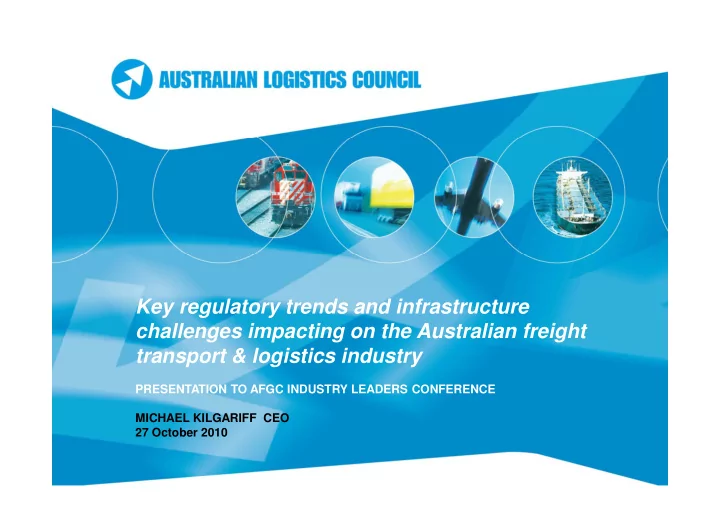

Key regulatory trends and infrastructure challenges impacting on the Australian freight transport & logistics industry PRESENTATION TO AFGC INDUSTRY LEADERS CONFERENCE MICHAEL KILGARIFF CEO 27 October 2010
The objectives of ALC are to: 1. Be the nationally recognised voice of the major participants in Australia’s domestic and international freight T&L supply chains. 2. Support appropriate nationally consistent regulatory frameworks and transparent markets to ensure Australia enjoys the full benefits of national freight T&L policy development and reform. 3. Promote the freight T&L industry’s image and profile and encourage greater recognition by governments and the community of the importance of the industry’s contribution to Australia’s economy. 4. Drive implementation of strategies to improve Australia’s domestic and international supply chains.
Economic Positioning of Freight T&L • Generates 14.5% of Australia’s GDP. • provides more than 1 m jobs across 165,000 companies. Treasury estimates that Australia’s population will increase to 35 million by 2050. Australia’s freight task has more than doubled over the last 20 years, is expected to almost double again by 2020, and triple by 2050.
A seamless Australian economy = One national law
2010 – COAG did not perform to expectations. COAG Reform Council • momentum had been lost in transport reform COAG should: • reinvigorate its transport reform agenda • develop a new coherent implementation plan for this reform.
Objective of the National Ports Strategy: to improve the efficiency of port related freight movements across infrastructure networks, minimise externalities associated with such freight movements and influence policy making in areas relevant to freight An essential component of the National Freight Network Plan.
National regulation and national regulators: • National rail safety regulator in Adelaide. • Marine safety authority in Canberra. • National heavy vehicle regulator in Brisbane.
National Heavy Vehicle Law will cover: • Heavy Vehicle Registration • Vehicle Standards • Heavy Vehicle Charges • Mass and Loading 364 issues • Oversize and Overmass Vehicles have been identified. • Restricted Access Vehicles • Higher Mass Limits • Compliance and Enforcement • Heavy Vehicle Driver Fatigue • Heavy Vehicle Speeding Compliance • Intelligent Access Program • Alternative Compliance.
COAG - Future Strategic Planning of Capital Cities. Greater pressure on: • transport infrastructure; • greenfield sites • residential intrusion/congestion around logistics infrastructure. National Ports Strategy freight is regarded as the ‘poor cousin’ of urban planning . Freight doesn’t vote
COAG Feasibility study for alternative models of road pricing and funding will be completed by December 2011, which should include specific consideration of mass-distance location pricing. Reform of road pricing • Encourage transport infrastructure providers to invest. • Encourage transport operators to make the right use of this infrastructure. • How much of a burden will the funding model impose? Henry - a fan of congestion charging
Incoming Government ‘Red Book’: • promoted greater investment in infrastructure. • highlighted the importance of forward planning. • warned the Gillard Government of the economic challenges they face. • Reform’ of Infrastructure Australia. • “continu(ed) work to reform heavy vehicle road user charging, and addressing urban transport congestion….”
Henry Tax Review Forum in mid 2011: Congestion charging – a Henry recommendation. Prime Minister Gillard – October 2010 Some of our reform policies you won't have read much about, like putting road user charges on heavy vehicles , and establishing national transport regulation to harmonise laws across state borders so the trucking industry pays its fair share of road construction and maintenance costs incurred by governments. Road user charging The drums are beating louder
The National Freight Plan: • should not be a process of ‘picking winners’ from a list of project. • should be to ensure the estimated freight task (eg 20 years) can be met.
Transport Regulatory Reform Agenda • replace confusing, complex and inconsistent laws by the Commonwealth, state and local governments. One national law for heavy vehicles. Chain of Responsibility • designed to drive greater accountability along the freight T&L supply chain by imposing duties on all elements of the T&L chain. • Industry driven compliance with CoR through the National Logistics Safety Code (NLSC) and the Retail Logistics Supply Chain (RLSC) Code of Conduct. • Reasonable steps defence A single economy requires a single set of road rules.
National Partnership Agreement: • land use decisions should prioritise the efficient operation of infrastructure identified as being nationally significant infrastructure; and • create a fund for state and local governments which incur expense as a result of making land-use decisions that favour nationally significant infrastructure over other land uses. A National Freight regulator
Freight Australia : • Commissioning and analysing data. • Identifying infrastructure of national significance. • Development of intermodal facilities. • Identifying blockages affecting the transport and logistics chain. • Advising Infrastructure Australia. • Encourage the transfer of information across the T&L chain. • Act as a ‘champion’ for the logistics industry within Government
Conclusion : • 2011-2013 pivotal years for T&L: • National regulators for rail/marine safety and heavy vehicles. • ALC is focussed on keeping up pressure on developing a national T&L market. • Australia requires a seamless approach nationally to: • Regulation. • Development of infrastructure. Thank you
Recommend
More recommend